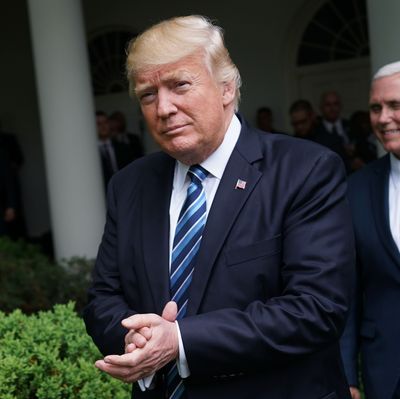
The first six months of the Trump administration have been marked by a massive revitalization of the U.S. manufacturing sector, an end to the lawlessness of the Obama years, and a new respect for America on the world stage, thanks to the president’s soaring, Reaganesque rhetoric — at least, that’s what this video released by the White House would have you believe:
In reality, President Trump is historically unpopular, and despite having a Republican-controlled Congress, he hasn’t passed any major legislation. Many measures Trump promised to enact on day one — including overhauling the tax code, building a wall on the southern border, and repealing and replacing Obamacare — have been delayed, curtailed, or possibly killed by disagreements within the GOP.
But amid all the chaos of President Trump’s first six months in office, he has managed to enact some measures that have a concrete effect on Americans’ lives. Here’s how Trump has changed America in the first eighth (or sixteenth) of his presidency:
Put Neil Gorsuch on the Supreme Court
Though Senate Majority Leader Mitch McConnell deserves the credit for stealing President Obama’s final Supreme Court appointment, technically it was Trump who replaced the late Justice Antonin Scalia with an equally conservative 49-year-old justice. As FiveThirtyEight notes, in his first few months on the job, Justice Gorsuch has proven to be just what conservatives were hoping for:
Gorsuch, in fact, may settle to the right of Scalia. In each of the 15 cases he’s weighed in on so far, Gorsuch has sided with the court’s single most conservative member, Justice Clarence Thomas. More than that, he’s joined every concurring opinion that Thomas has issued so far. That is, he didn’t just agree with Thomas on the outcomes of the case but also with the reasoning by which those outcomes were reached.
Some justices have moved to the left during their time on the court, and you never know when a conservative will surprise you by repeatedly saving Obamacare. So far Gorsuch has only been the deciding voice on two votes: one that made it harder to file some class-action claims, and another that made it more difficult for death-row inmates to make inadequate legal representation part of their appeal.
End the Paris Climate Agreement
In June, President Trump announced that the U.S. would pull out of the Paris climate accord. He said he decided to withdraw because the deal would hurt the American economy and U.S. workers, though experts say that’s untrue. He reportedly saw disappointing our European allies as “a secondary benefit.”
President Trump has taken a number of other steps that have alarmed environmentalists, such as approving the Dakota Access Pipeline project and clearing the way for the construction of the Keystone XL oil pipeline from Canada. In his first 100 days, Trump rolled back around two dozen environmental rules and regulations.
It’s impossible to measure the precise effect of Trump’s actions, since many say the Paris agreement isn’t aggressive enough anyway, and other world and local leaders are taking action regardless of White House policy. But the fact that the leader of the world’s second-largest source of climate pollution is working against solving global warming certainly takes us one step closer to a terrifying future.
Enact a (Partial) Travel Ban
While it’s a far, far cry from the “total and complete shutdown of Muslims entering the United States” that Trump called for on the campaign trail, he has managed to prevent some Muslims and all refugees from entering the country for the next few months.
The executive order Trump signed in January banned people from seven Muslim-majority countries from entering the U.S. for 90 days, and blocked all refugees for 120 days. Following a disastrous rollout and a number of legal challenges, the administration issued a revised travel ban in March. Late last month, the Supreme Court said a version of that ban could go into effect as we await arguments on the constitutionality of the order in October.
After even more legal wrangling, the travel ban is currently only barring two groups from the U.S.: 1) People from Libya, Iran, Yemen, Syria, Somalia, and Sudan who have no familial connection with a resident of the U.S., and 2) all refugees, even if they have a relationship with a U.S. resettlement agency. Lawyers for Hawaii, which is challenging the ban, said there are about 24,000 refugees who have a formal assurance from a resettlement agency, yet cannot enter the country.
Build a (Prototype) Border Wall
“Build a wall and make Mexico pay for it” might be Trump’s most famous campaign pledge. Six months into his administration, we’re still a long, long way from the president making good on that promise, but construction will soon be underway.
The problem is that, regardless of what Trump decrees, he needs Congress to provide the money. (Oh, and by the way: the U.S. will be paying for the wall.) An internal Department of Homeland Security report estimated that it would cost $21.6 billion to seal the border with another 1,250 miles of wall and fencing. The Trump administration asked for $3.6 billion in the 2017 and 2018 budgets to build about 100 miles of wall. Last week, the House Appropriations Committee approved a spending bill with just $1.6 billion for 74 miles of fencing.
The idea of an impenetrable border wall still sounds highly implausible (especially now that Trump wants it to be coated in solar panels). But DHS is moving forward with the plan. In March the government began accepting bids from contractors to build prototype walls, and last week DHS said preliminary preparations for the construction are underway. The New York Times reports:
Engineers are drilling and taking soil samples to determine what type of barriers would be most effective in the different types of geography along the border, said David Lapan, a spokesman for the Department of Homeland Security.
The drilling and soil testing are taking place in El Paso; Santa Teresa, N.M.; Calexico, Calif.; and the Rio Grande Valley in South Texas. Mr. Lapan said the testing has been completed in El Paso and Calexico. The agency has identified the San Diego area and the Rio Grande Valley as priority regions for new border walls. The [U.S. Army Corps of Engineers] will begin work in the San Diego area in August.
Crackdown on Illegal Immigration
Trump’s most consequential immigration-related action may be his expansion of deportation priorities. In 2014, the Obama administration prioritized “members of gangs; those convicted of felonies or aggravated felonies; and those suspected of or engaged in terrorist or espionage activity” for deportation. An executive order that President Trump signed in January broadened the priorities for deportation to include people who “have committed acts that constitute a chargeable criminal offense,” which could include anyone who entered the country illegally.
The order gave rank-and-file Immigration and Customs Enforcement agents more discretion about who to target, and led to a significant increase in arrests. According to USA Today, ICE arrested an average of 13,085 people each month from February through June. The average in the last three months of the Obama administration was 9,134 arrests per month.
As Vox explains, ICE agents aren’t being totally indiscriminate in who they arrest, but it appears that they’re more willing to go after easy targets. ICE said that 75 percent of the immigrants arrested in the first 100 days of the Trump administration had some previous criminal conviction (which may have been minor).
It’s not clear why or how ICE picked up the other 10,000 immigrants, who had no criminal record but got arrested by immigration agents anyway. But the anecdotal evidence that’s emerged over the past few months indicates that ICE agents are going after immigrants they have already identified and tracked: either people who already have prior orders of deportation or who have been ordered to check in with ICE at regular intervals.
Reports of large raids and ICE targeting people in vulnerable situations — like people reporting domestic violence and a woman with a brain tumor — have created a new wave of fear in immigrant communities. But while there are more arrests under Trump, deportations are actually down. There were an average of 22,705 deportations per month in the last three months of the Obama administration, but from February to June, an average of 16,895 people were deported each month. There was already a large backlog in federal immigration courts before the Trump administration started adding to the ranks of those up for deportation.
Still, the Trump administration claims the president’s policies are deterring people from attempting to enter the country illegally in the first place. The number of people arrested while trying to cross the southwest border is down 40 percent since Trump took office. It’s too early to tell if that’s an aberration or the start of a long-term trend.
Deregulation
Shortly after taking office President Trump signed an executive order requiring federal agencies to cut two existing regulations for every new regulation, and established task forces in every agency for “removing job killing regulations and increasing economic opportunity.” Working with congressional leaders, Trump made unprecedented use of the obscure Congressional Review Act to quickly undo 13 regulations passed under President Obama. Last week the administration announced that it has already withdrawn or delayed 860 proposed regulations.
While many conservatives applaud Trump for getting the government out of people’s lives, critics point out that regulations aren’t inherently bad. For instance, the Obama measures Trump did away with made it harder for mentally ill people to buy a gun, required government contractors to disclose labor-law violations, and prohibited broadband providers from tracking customers’ online activity without their permission.
Plus, the near-standstill in issuing new regulations has created problems in some industries. According to Politico, the “two-for-one” order is believed to be holding up long-awaited regulations, such as an Environmental Protection Agency rule on the disposal of mercury by dentists and the Federal Aviation Administration’s guidelines for the operation of commercial drones over people. Several liberal groups have already sued Trump over the “two-for-one” order, and consumer and environmental groups may follow if agencies don’t start issuing regulations.
But for now, the White House is counting deregulation as an achievement.
“As you see, on a daily basis, we’re getting rid of regulation,” Trump said last month. “My administration has been laser-focused on removing the government barriers to job growth and prosperity.”






























